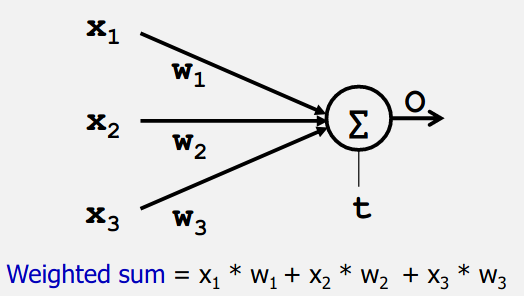Introduction to Machine Learning
Neural Networks
Instead of writing program by hand, give computer a lot of examples / data with the output, so computer can learn to improve
Machine Learning
Machine learning is concerned with computer programs that automatically improve their performance through experience
Study of computer algorithms that can improve automatically through experiences without being explicitly programmed
- Top-down/Classic: model all different functions and wire all these 'agents' together
- Bottom-up / Deep learning: give the system a lot of data
Artificial Neural Networks
- Simulate, in the computer, neural networks in the brain
- McCulloh and Pits (1943): 1st neural networks
- Combine simple inputs, idea of threshold
- Weights design by humans
- Hebb (1949): First learning rule
- Would adjust weights as it was ran
- 50s/60s
- Perceptrpm: great excitement
- Coverage to correct weights: learning thinking
- 1969: death/winter of ANN
- Perceptron cant learn certain type of important functions (non- linear separable)
- Mid 80s: discovered multi-layer networks to solve problem of non-linear separable
Neurons
- Signals "move" between neurons
- Sum of inputs >= threshold, neuron fires (output of 1)
- Long-term firing patters - basing learning
- Theory behind first neural network
- McCulloch and Pitts produced the 1st neural networks in 1943
First Neural Networks
- Fundamental processing unit of a brain: a neuron
- A processing element - (neuron)
- Inputs (dendrites)
- Output (axon)
- Weights (synapses)
Positive weight: excitatory, otherwise inhibitory
 As long as the sum is above the threshold its correct
As long as the sum is above the threshold its correct

Training a NN
Weights are normally randomly assigned
- Epoch: Entire training set feed into the neural network. The AND function: an epoch consists of four sets of inputs(patterns) feed into the network
- Training Value, T: Value that we require the network to produce
- Error, Err: The amount the output by the network O differs from the training value T
- X_i: Inputs to Neuron
- w_i: Weight from input X_i, to the output
- LR (Learning Rate) How quickly the network converges. It is set by the experimentation, typically 0.1. This is the adjustment amount
While epoch produces an error
Check next inputs(pattern) from epoch
Err = T - O
If Err <> 0 then
w_i = w_i + LR * X_i * Err
End If
End While
Performance Measure:
- Mean squared error =
[(T-O)^2]/n- (n) number of items
Linearly Separable: Functions which can be separated. Only linearly separable functions can be represented by a single layer NN, i,e, perception
If you can separate your inputs and outputs with a straight line then you have found the weights

Current AI Developments
AlphaCode - Writes computer programs at a competitive level. Ranked top 54% in real-world programming competitions
Deep Learning - Fathers of Deep Learning, Handwriting image recognition, language processing, vision etc.
Learning From Experience - Deep neural networks learn by adjusting the strengths of their connections to better convey input signals through multiple layers to neurons associated with the right general concepts